Dosing & Uses
Dosage Forms & Strengths
ophthalmic suspension
- 0.12%
- 1%
ophthalmic solution
- 0.11%
- 0.9%
- 1%
Ophthalmic Inflammatory Conditions
1-2 gtt of 1% solution BID-QID (may be more frequent during initial 24-48 hr)
Conjunctivitis
1-2 gtt of 1% solution BID-QID (may be more frequent during initial 24-48 hr)
See also combo with gentamicin
Other Indications & Uses
Ocular corticosteroid, antiinflammatory agent
Effective in iritis, keratitis, conjunctivitis, and many ocular inflammatory diseases; bacterial and viral infections require concomitant antibacterial and antiviral coverage, respectively
Dosage Forms & Strengths
ophthalmic suspension
- 0.12%
- 1%
ophthalmic solution
- 0.11%
- 0.9%
- 1%
Ophthalmic Inflammatory Conditions
1-2 gtt of 1% solution BID-QID (may be more frequent during initial 24-48 hr)
Conjunctivitis
1-2 gtt of 1% solution BID-QID (may be more frequent during initial 24-48 hr)
See also combo with gentamicin
Adverse Effects
Frequency Not Defined
Increased IOP
Ocular hypertension
Conjunctival hyperemia
Conjuctivitis
Corneal ulcers
Delayed wound healing
Glaucoma
Keratitis
Loss of accommodation
Optic nerve damage
Mydriasis
Posterior subcapsular cataract formation
Ptosis
Secondary ocular infection
Hypercorticoidism (rare)
Postmarketing Reports
Eye pain
Cushing’s syndrome and adrenal suppression (after very frequent use of ophthalmic prednisolone, particularly in very young children)
Warnings
Contraindications
Hypersensitivity
Acute untreated purulent ocular infections, in most viral diseases of cornea and conjunctiva including epithelial herpes simplex keratitis (dendritic keratitis), vaccinia, and varicella, and also in mycobacterial infection of the eye and fungal diseases of ocular structures
Cautions
Use ocular steroids cautiously
Prolonged use of corticosteroids may result in posterior subcapsular cataract formation and may increase intraocular pressure in susceptible individuals, resulting in glaucoma with damage to the optic nerve, defects in visual acuity and fields of vision
Prolonged use may also suppress the host immune response and thus increase the hazard of secondary ocular infections
Routinely monitor intraocular pressure if this product is used for 10 days or longer
Use caution in the presence of glaucoma; frequently check intraocular pressure
Various ocular diseases and long-term use of topical corticosteroids have been known to cause corneal and scleral thinning
Use of topical corticosteroids in the presence of thin corneal or scleral tissue may lead to perforation
Acute purulent infections of the eye may be masked or activity enhanced by the presence of corticosteroid medication
The use of steroids after cataract surgery may delay healing and increase the incidence of bleb formation
Use of ocular steroids may prolong the course and may exacerbate the severity of many viral infections of the eye (including herpes simplex)
Employment of a corticosteroid medication in the treatment of patients with a history of herpes simplex requires great caution; frequent slit lamp microscopy is recommended
Suspension formulation contains sodium bisulfite, a sulfite that may cause allergic-type reactions, including anaphylactic symptoms and life-threatening or less severe asthmatic episodes in certain susceptible people
The overall prevalence of sulfite sensitivity in the general population is unknown and probably low; sulfite sensitivity is seen more frequently in asthmatic than in non-asthmatic people
The initial prescription and renewal of medication order beyond 20 milliliters of suspension should be made by a physician only after examination of the patient with the aid of magnification, such as slit-lamp biomicroscopy, and, where appropriate, fluorescein staining; if signs and symptoms fail to improve after 2 days, the patient should be re-evaluated
As fungal infections of the cornea are particularly prone to develop coincidentally with long-term local corticosteroid applications, fungal invasion should be suspected in any persistent corneal ulceration where a corticosteroid has been used or is in use; fungal cultures should be taken when appropriately
Pregnancy & Lactation
Pregnancy Category: C
Lactation: not known if distributed in milk
Pregnancy Categories
A: Generally acceptable. Controlled studies in pregnant women show no evidence of fetal risk.
B: May be acceptable. Either animal studies show no risk but human studies not available or animal studies showed minor risks and human studies done and showed no risk. C: Use with caution if benefits outweigh risks. Animal studies show risk and human studies not available or neither animal nor human studies done. D: Use in LIFE-THREATENING emergencies when no safer drug available. Positive evidence of human fetal risk. X: Do not use in pregnancy. Risks involved outweigh potential benefits. Safer alternatives exist. NA: Information not available.Pharmacology
Mechanism of Action
Inhibits edema, fibrin deposition, capillary dilation, and phagocytic response of acute inflammation; also inhibits capillary proliferation, collagen deposition, and scar formation
Pharmacokinetics
Absorption: Corneal penetration is good; absorbed into aqueous humor and some systemic absorption
Excretion: Urine
Images
| BRAND | FORM. | UNIT PRICE | PILL IMAGE |
|---|---|---|---|
| Pred Forte ophthalmic (eye) - | 1 % drops | 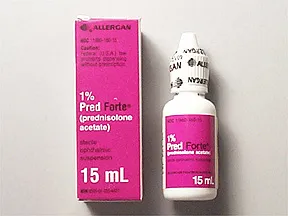 | |
| Pred Forte ophthalmic (eye) - | 1 % drops | 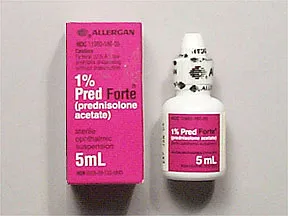 | |
| Pred Forte ophthalmic (eye) - | 1 % drops | 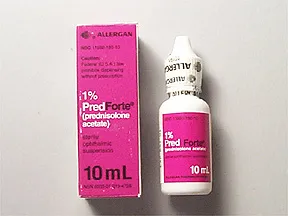 | |
| prednisolone acetate ophthalmic (eye) - | 1 % drops | 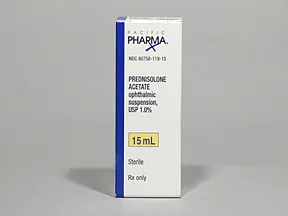 | |
| prednisolone acetate ophthalmic (eye) - | 1 % drops |  | |
| prednisolone acetate ophthalmic (eye) - | 1 % drops | 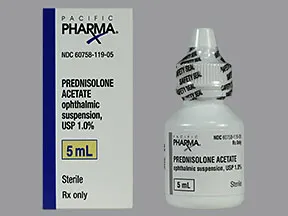 | |
| prednisolone acetate ophthalmic (eye) - | 1 % drops |  | |
| prednisolone acetate ophthalmic (eye) - | 1 % drops | 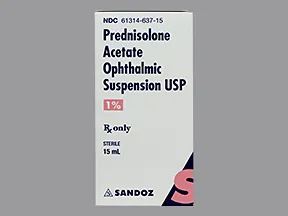 | |
| prednisolone acetate ophthalmic (eye) - | 1 % drops | 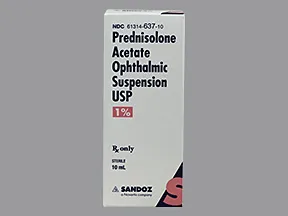 | |
| Pred Mild ophthalmic (eye) - | 0.12 % drops | 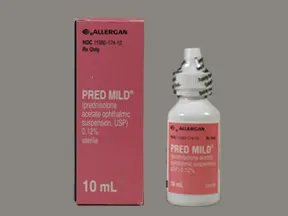 | |
| Pred Mild ophthalmic (eye) - | 0.12 % drops | 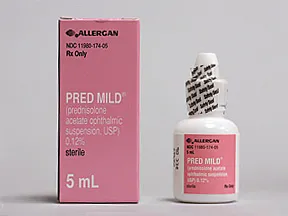 |
Copyright © 2010 First DataBank, Inc.
Patient Handout
prednisolone acetate ophthalmic (eye)
PREDNISOLONE - OPHTHALMIC
(pred-NIS-oh-loan)
COMMON BRAND NAME(S): Pred Forte, Pred Mild
USES: This medication is used to treat certain eye conditions due to inflammation or injury. Prednisolone works by relieving symptoms such as swelling, redness, and itching. It belongs to a class of drugs known as corticosteroids.
HOW TO USE: Use this medication in the affected eye(s) as directed by your doctor, usually 2 to 4 times a day.Unless otherwise directed by your doctor, do not wear contact lenses while you are using this medicine. Sterilize contact lenses according to the manufacturer's directions, and check with your doctor before you begin using them again.If your doctor does approve the wearing of contact lenses during treatment with this medication, remove the lenses before using the eye drops. The preservative in this product may be absorbed by contact lenses. Wait at least 15 minutes after each dose of the eye drop before wearing the lenses again.To apply eye drops, wash your hands first. If you are using a suspension form of this medication, shake the bottle well before using. To avoid contamination, do not touch the dropper tip or let it touch your eye or any other surface.Tilt your head back, look upward, and pull down the lower eyelid to make a pouch. Hold the dropper directly over your eye and place 1 drop into the pouch. Look downward and gently close your eyes for 1 to 2 minutes. Place one finger at the corner of your eye (near the nose) and apply gentle pressure. This will prevent the medication from draining out. Try not to blink and do not rub your eye. Repeat these steps for your other eye if so directed and if your dose is for more than 1 drop.Do not rinse the dropper. Replace the dropper cap after each use.If you are using another kind of eye medication (for example, other drops or ointments), wait at least 5 to 10 minutes before applying other medications. Use eye drops before eye ointments to allow the drops to enter the eye.Wait several minutes for your vision to clear before driving or operating machinery.Use this medication regularly in order to get the most benefit from it. To help you remember, use it at the same time(s) each day.The dosage and length of treatment are based on your medical condition and response to treatment. Do not use this medication more often or for longer than prescribed because doing so may increase your risk of side effects.Continue to use this medication for the full time prescribed. Do not stop using this medication without consulting your doctor. Some conditions may become worse when the drug is suddenly stopped. Your dose may need to be gradually decreased.Do not use this product if it becomes contaminated (for example, drops turn a dark color). Use of contaminated eye medication can cause infection, serious damage to the eye, and loss of vision. Contact your doctor or pharmacist for more information.Tell your doctor if your condition does not improve after 2 days or if it worsens.
SIDE EFFECTS: Rarely, stinging/burning of the eyes for 1 to 2 minutes may occur when you apply this medication. If any of these effects last or get worse, tell your doctor or pharmacist promptly.Remember that this medication has been prescribed because your doctor has judged that the benefit to you is greater than the risk of side effects. Many people using this medication do not have serious side effects.Use of this medication for prolonged periods or in high doses may cause serious eye problems (such as high pressure inside the eyes and cataracts). Tell your doctor right away if any of these serious side effects occur: vision problems, eye pain.This medication may mask the signs of an eye infection. It may also put you at greater risk of developing an eye infection, especially with prolonged use. Report any new or worsening symptoms such as eye discharge/swelling/redness, vision problems, or no improvement of your current eye condition. Your doctor will need to adjust your treatment.Tell your doctor right away if you have any serious side effects, including: headache, dizziness.A very serious allergic reaction to this drug is rare. However, get medical help right away if you notice any symptoms of a serious allergic reaction, including: rash, itching/swelling (especially of the face/tongue/throat), severe dizziness, trouble breathing.This is not a complete list of possible side effects. If you notice other effects not listed above, contact your doctor or pharmacist.In the US -Call your doctor for medical advice about side effects. You may report side effects to FDA at 1-800-FDA-1088 or at www.fda.gov/medwatch.In Canada - Call your doctor for medical advice about side effects. You may report side effects to Health Canada at 1-866-234-2345.
PRECAUTIONS: Before using prednisolone, tell your doctor or pharmacist if you are allergic to it; or if you have any other allergies. This product may contain inactive ingredients (such as sulfites found in some brands), which can cause allergic reactions or other problems. Talk to your pharmacist for more details.Before using this medication, tell your doctor or pharmacist your medical history, especially of: eye infections, recent eye surgery, cataracts, glaucoma (open-angle type), severe nearsightedness (myopia), diabetes.After you apply this drug, your vision may become temporarily blurred or unstable. Do not drive, use machinery, or do anything that needs clear vision until you can do it safely.Before having surgery, tell your doctor or dentist about all the products you use (including prescription drugs, nonprescription drugs, and herbal products).If you develop a new eye infection or injury, or require eye surgery, ask your doctor if you should continue to use your current bottle of prednisolone eye drops or start a new bottle.During pregnancy, this medication should be used only when clearly needed. Discuss the risks and benefits with your doctor.It is unknown if this medication passes into breast milk. Consult your doctor before breastfeeding.
DRUG INTERACTIONS: Drug interactions may change how your medications work or increase your risk for serious side effects. This document does not contain all possible drug interactions. Keep a list of all the products you use (including prescription/nonprescription drugs and herbal products) and share it with your doctor and pharmacist. Do not start, stop, or change the dosage of any medicines without your doctor's approval.
OVERDOSE: This medicine may be harmful if swallowed. If someone has overdosed and has serious symptoms such as passing out or trouble breathing, call 911. Otherwise, call a poison control center right away. US residents can call 1-800-222-1222. Canada residents can call 1-844-764-7669.
NOTES: Do not share this medication with others.This medication has been prescribed for your current condition only. Do not use it later for another eye condition unless told to do so by your doctor. A different medication may be necessary in that case.Lab and/or medical tests (such as eye exams, measurement of the pressure inside the eyes) may be done while you are using this medication. Keep all medical and lab appointments. Consult your doctor for more details.
MISSED DOSE: If you miss a dose, use it as soon as you remember. If it is near the time of the next dose, skip the missed dose. Use your next dose at the regular time. Do not double the dose to catch up.
STORAGE: Store at room temperature away from light. Different brands of this medication have different storage needs. Check the product package for instructions on how to store your brand, or ask your pharmacist. Do not freeze. Keep the bottle upright and tightly closed when not in use. Keep all medications away from children and pets.Do not flush medications down the toilet or pour them into a drain unless instructed to do so. Properly discard this product when it is expired or no longer needed. Consult your pharmacist or local waste disposal company.
Information last revised May 2024. Copyright(c) 2024 First Databank, Inc.
IMPORTANT: HOW TO USE THIS INFORMATION: This is a summary and does NOT have all possible information about this product. This information does not assure that this product is safe, effective, or appropriate for you. This information is not individual medical advice and does not substitute for the advice of your health care professional. Always ask your health care professional for complete information about this product and your specific health needs.
Formulary
Adding plans allows you to compare formulary status to other drugs in the same class.
To view formulary information first create a list of plans. Your list will be saved and can be edited at any time.
Adding plans allows you to:
- View the formulary and any restrictions for each plan.
- Manage and view all your plans together – even plans in different states.
- Compare formulary status to other drugs in the same class.
- Access your plan list on any device – mobile or desktop.



